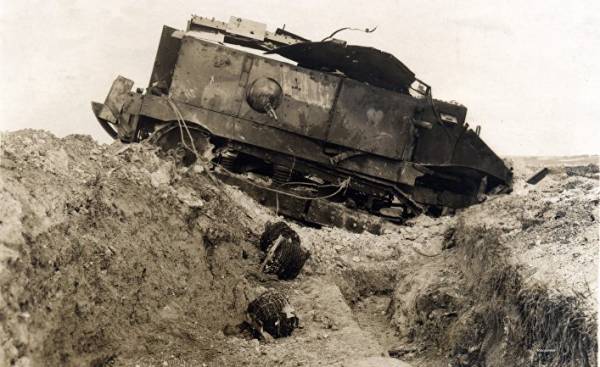
Usually a smart person avoids repeating known mistakes. Chief of the General staff of France Robert Nivelle was the commander of the army of experienced and resourceful officer. More surprising that in the spring of 1917, he repeated he is well familiar catastrophic error by his German opponent.
To attack a fortified position of the enemy, in itself, is difficult to calculate the risk that, despite the enormous material costs with doubtful success can lead to terrible losses. It showed the joint Franco-British offensive on the Somme in 1916.
However, if your soldiers in the attack still have to fight your way up the slope, failure is almost guaranteed. That Nivelle had experienced at Verdun. There, in February 1916 the Germans launched a major offensive, especially against deliberately strengthened the Central point of the front line. By responding intelligently, Nivelles stopped this attack and prevented the enemy breakthrough.
Why, in April 1917, he almost exactly repeated the failed strategy of the Germans? On Easter Monday, April 9, first British and canadian troops near Arras attacked the German trenches. They managed only 12 hours to capture Vimy ridge (though not particularly high and steep); and then attack, of course, stalled.
A week later the main forces of Nivelles 140 kilometers South-East attacked the German positions on the Chemin des dames, the chain of hills between the chaplain and Reims over the valley of the river Aisne. To attack here was even crazier than wooded, riddled with ravines of the territory of Verdun.
However, Nivelle was of the opinion that you will be able to achieve a decisive breakthrough. Why? As a trained gunner he as effectively and creatively arranged the use of the French guns at the battle of the Marne in September 1914 — and probably that he defended Paris from the advancing German army. The result was a higher rank then Colonel to Brigadier General.
During fierce battles for Verdun he was one of the organizers of the defense of France; he distinguished himself at the same time, writes military historian Jean-Jacques Becker (Jean-Jacques Becker) as “one of the most brilliant and inventive leaders of the French army” and “a real winner in battle.”
His most important innovation was treated the exact coordination “Barrage roulant”, “barrage”, going ahead of his troops, who, under the protection of the barrage of shells moved forward. It’s just sounds, but very hard to organize, so as to avoid losses from friendly fire.
The government in Paris thought that Nivelles is the best candidate to succeed commander and chief of the General staff Joseph Joffre (Joffre, Joseph), who at the end of 1916 had already been exhausted, in comparison with his boss during the battle of Verdun Philippe Pétain (Pétain, Philippe), who was his senior by only a few months. In addition, half British (his mother was originally from England), Nivelle came to support contacts with the main ally — Britain.
Despite this, its coming from the middle of April 1917 was insane. Perhaps Nively located in the position of commander-in-chief no more than six months, it seemed that he has a secret weapon: the first French tank, the Schneider CA-1. About 130 vehicles of this type entered in March 1917 to the front. It was about simple vehicles with an engine from American caterpillar tractor, with armor from five to eleven millimeters of steel, a short 75-millimeter cannon and two machine guns.
Nivelle planned to capture the first two systems of trenches the German troops on the slope of the Chemin des dames with a sudden attack of infantry after a devastating barrage of his artillery. Then the tanks, despite their maximum speed of eight kilometers per hour, slightly faster than the speed of step, was to further boost the rate of occurrence.
Even in theory it was risky. In practice, the execution went terribly. French infantry not only suffered heavy losses, but almost never able to achieve his goal, the third and the most fortified German lines of trenches. Even when the tanks made earlier than planned, nothing has changed: instead of the third and fourth fortifications were able to capture only a small part of the third trench.
48 hours after the attack began, the French troops had been stalled; out of about 130 existing tanks Schneider CA-1 for nearly 80 were damaged or burned. Most of them were destroyed by indirect hits from German guns. Still damaged 20 cars were evacuated and repaired. A third of the crew died or was seriously injured.
Nevertheless Nivelle did not retreat from his plan. During the week he gave new instructions to his troops to force a breakthrough it is on Chemin des dames. At this time, the amount of losses amounted to 30 thousand dead and 100 thousand wounded — only on the French side.
Only now responded to some of the officers in his entourage, and then, and quite independently, the people on the front — they simply refused to obey orders to attack. Policy, quickly concluded: April 29, 1917, pétain was appointed chief of the General staff, and may 15, he replaced the unsuccessful Nivelle and the post of commander in chief.
His offensive “a complete failure”, rightly wrote military historian Marcus Bellmann (Markus Pöhlmann). The General needed to answer even before a Commission of inquiry, but in October 1917 he was acquitted. It was not surprisingly still in full swing, battles were fought. If Robert Nivelle was convicted in 1919, it is possible that the verdict would have been different.







